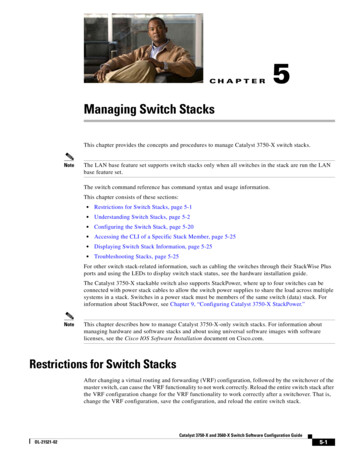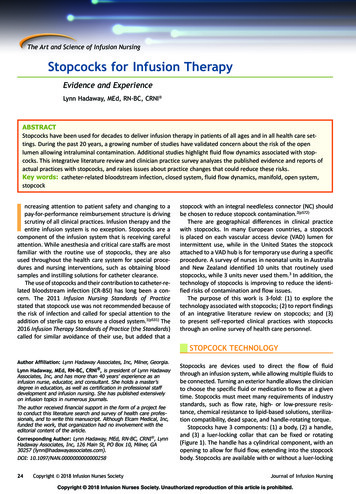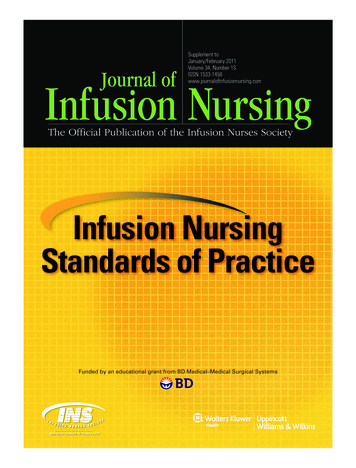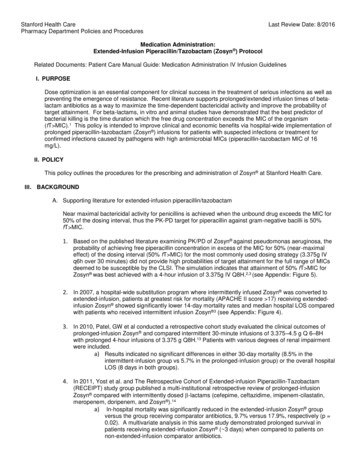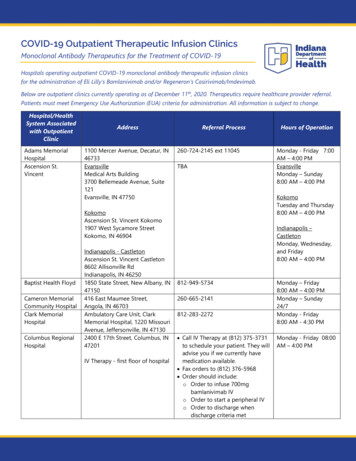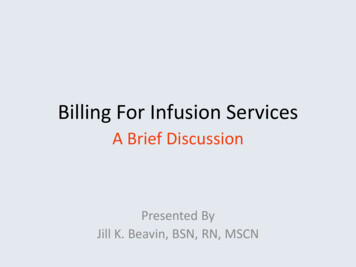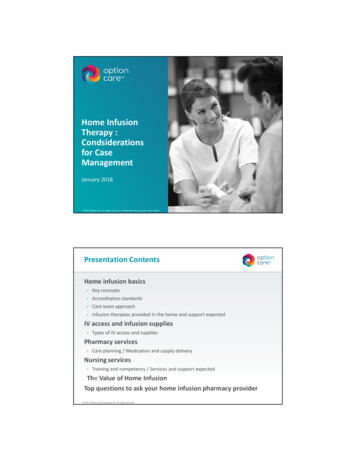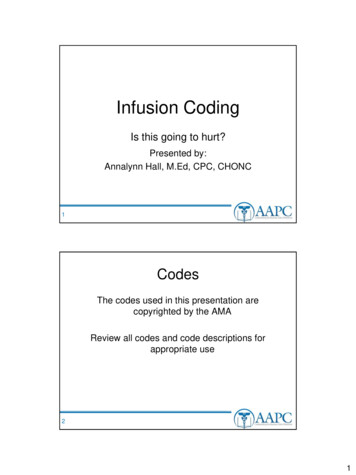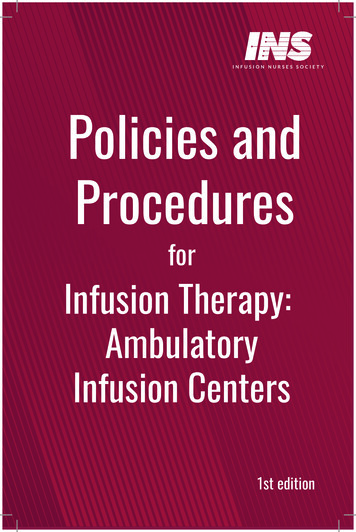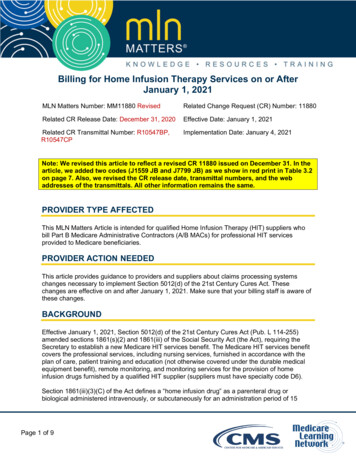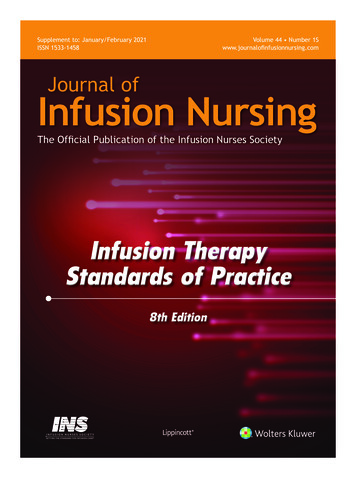
Transcription
Supplement to: January/February 2021ISSN 1533-1458Volume 44 Number 1Swww.journalofinfusionnursing.comJournal ofInfusion NursingThe Official Publication of the Infusion Nurses SocietyInfusion TherapyStandards of Practice8th EditionNANv44n1S-Cover.indd 112/30/20 12:57 AM
Infusion TherapyStandards of PracticeLisa Gorski, MS, RN, HHCNS-BC, CRNI , FAANLisa A. Gorski, MS, RN, HHCNS-BC, CRNI , FAANLynn HadawayLynn Hadaway, MEd, RN, NPD-BC, CRNI Mary E. Hagle, PhD, RN-BC, FAANMary E. Hagle, PhD, RN-BC, FAANDaphne Broadhurst, MN, RN, CVAA(C)Daphne Broadhurst, MN, RN, CVAA(C)Simon ClareSimon Clare, MRes, BA, RGNTricia Kleidon, MNSc (Nurs. Prac), BNSc, RNTricia Kleidon, MNSc (Nurs. Prac), BNSc, RNBritt Meyer, PhD, RN, CRNI , VA-BC, NE-BCBritt M. Meyer, PhD, RN, CRNI , VA-BC, NE-BCBarbara NickelBarb Nickel, APRN-CNS, CCRN, CRNI Stephen Rowley, MSc, BSc (Hons), RGN, RSCNStephen Rowley, MSc, BSc (Hons), RGN, RSCNElizabeth Sharpe, DNP, APRN-CNP, NNP-BC, VA-BC, FNAP, FAANPElizabeth Sharpe, DNP, APRN-CNP, NNP-BC, VA-BC, FNAP, FAANP, FAANMary Alexander, MA, RN, CRNI , CAE, FAANMary Alexander, MA, RN, CRNI , CAE, FAAN8TH EDITION8TH EDITIONREVISED 2021REVISED 2021One Edgewater Drive, Norwood, MA 02062One EdgewaterDrive, Norwood, MA 02062www.ins1.orgwww.ins1.org
L EAR N MO RE A T W W W. I NC C1 .O R G
The Art and Science of Infusion NursingJournal ofInfusion NursingEditorINS Board of DirectorsMary Alexander, MA, RN, CRNI *,CAE, FAANPresidentAngie Sims, MSN, RN, CRNI , OCN Associate Managing EditorPresident ElectSue Weaver, PhD, RN, CRNI , NEA-BCDirectors-at-LargeNancy Bowles, MHA, RN, OCN , CRNI ,NEA-BE, CPC-AAngela Skelton, BSN, RN, CRNI Leslie NikouPresidential AdvisorLynn Deutsch, MSN, RN, CRNI , VA-BCPublic MemberJohn S. Garrett, MD, FACEPSecretary/TreasurerInez Nichols, DNP, FNP-BC, CRNI , VA-BCINS Chief Executive OfficerMary Alexander, MA, RN, CRNI , CAE, FAANEditorial OfficesInfusion Nurses Society (INS)One Edgewater Drive, Suite 209Norwood, MA 02062Main Office: (781) 440-9408www.ins1.orgJournal of Infusion Nursing, the officialpublication of INS, seeks to promoteexcellence in infusion nursing by presentingnew research, clinical reviews, case studies,and professional development informationrelevant to the practice of infusion therapy.Articles undergo a process of double-blindpeer review. Final selections represent thebroad scope of the infusion specialty and drawon the expertise of all health care providerswho participate in the delivery of infusion.For advertising information:National Account ManagerKelle Ramsaykelle.ramsay@wolterskluwer.com(410) 528-4121Recruitment AdvertisingLaury Chervil-Gilles (West)laury.chervil-gilles@wolterskluwer.com(646) 674-6322Monique McLaughlin (East)monique.mclaughlin@wolterskluwer.com(215) 521-8468Infusion Therapy Standards of Practice ReviewersThe revised Standards, 8th edition, was peer-reviewed by a panel of individuals across health care specialties from 17 countries around the globe. The feedback provided helped tofurther strengthen the recommendations outlined in this revision. The Standards of Practice Committee would like to thank the following list of reviewers:Cindi Acree, DNP, APRN, NNP-BC, MEd, CPHQ, CPECJeanette Adams, PhD, APRN, CRNI Tahani Al Dweikat, BSN, EMHCA, OCN Grace Al Hakim, MSN, RN, AGCNS-BCFatima Dawood Aldawood, B.S.Micr, BSN, RN, ICPEvan Alexandrou, PhD, MPH, RN, BHealth, ICU CertSharif D. Alnatour, MBAn(c), MHCM, BScN, CNML, NPD-BC,RN-BC, CPHONJen Andrade, BSN, RNAlicia Arnold, BSN, RN, CRNI Nabil Bayan, MD, EMADeborah Barrio Belisle, MBA, MSN, BS, RNDawn Berndt, DNP, RN CRNI Corinne Bishop, RN, CRNI Nancy Bowles, MHA, RN, OCN , CRNI , NEA-BE, CPC-ASusan Bowles, DNP, APRN, RNC-NIC, CBCDaiane Patricia Cais, MSN, RNElizabeth Campbell, MSN, RN, CRNI Trisha Campbell, MSN, RN, CRNI , OCN Peter Carr, PhD, MMedSc, BSc, RNChris Cavanaugh, BSN, RN, CRNI , VA-BCRaquel Bauer Cechinel, MSc, MBA, BSN, RNLynda Cook, MSN, RN, CRNI Jill Culiner, MSN, RN, ANPCaroline Cullinane, BA (hons) class 1, Dip HE, RNKerri Dalton, MSN, APRN, AOCNSLynn Deutsch, MSN, RN, CRNI , VA-BCMichelle DeVries, MPH, CIC, VA-BCIlker Devrim, MDAlicia Dickenson, BSN, RN, CRNI , VA-BCDarcy Doellman, MSN, RN, CRNI , VA-BCLoretta Dorn, MSN, RN, CRNI Martina Douglas, MSc, RNDenise Dreher, RN, CRNI , VA-BCMelanie Eld, PhD, RNKari Ertmer, BSN, RN, PHN, VA-BCBeth Fabian, BA, RN, CRNI Whitney Ficocello, BSN, RN, PHNBeverly George, MS, BSN, RN, CRNI Ginger Gillette-Kent, MSN, MBA, APRN, ANP-BC, NEA-BCKaren Giuliano, PhD, RN, FAANBrenda Gray, PharmD, VA-BC, BCNSP, CNSC, CVAA(c), PRSVikram Guduri, MBBSCarole Hallam, MSc, BSc, RNJocelyn Hill, MN, RN, CVAA(c), VA-BCSteve Hill, Dip, PgdKlaus Hoerauf, MD, PhDJoseph M. Hommes, BSN, RN, VA-BCSun Hong, MSN, RNCynthia Huff, DNP, RN, OCN , CRNI , CNLRobin Huneke Rosenberg, MA, RN, CRNI , VA-BCKristopher Hunter, BSN, RN, CRNI , VA-BCMark Robert Hunter, MS, BSN, RN, CRNI , VA-BCPamela Jacobs, MHA, BSN, RN, CRNI , OCN Vladimir Jaksic, MDCaroline Johnson, MSN, RN, PHNJames M. Joseph, MPH, BSN, RN, CRNI , VA-BCLori Kaczmarek, MSN, RN, VA-BCLinda J. Kelly, PhD, RGN, PGC (TLHE), FHEA, TCHPatricia C. Kienle, MPA, BCSCP, RPh, FASHPChristina Klein, MSN, RN, CRNI , OCN Judith A. LaJoie, MS, BSN, RN, CRNI Lynette Lennox, MHLTH, RNSusan Lown, DNP, RN, CNEGail Lusardi, RNAngie Malone, DNP, APRN, ACNS-BC, OCN , AOCNS, NE-BCAlicia Mares, BSN, RN, CRNI Nicole Marsh, PhD, RNSheryl McDiarmid, MBA, MEd, BSCN, RN, AOCN , ACNP,CVAA(c), CRNI Mary McGoldrick, MS, RN, CRNI Diana Melton, MSHA, BSN, RNCrystal Miller, MA, BS, RN, CRNI Shafii Mohammed, DNP, MPH, CIC, FRSPHNancy Moureau, PhD, BSN, RN, CRNI , VA-BC, CPUIRuss Nassof, JDElena Nelson Squires, BSN, RN, OCN , VA-BCJackie Nicholson, MSc, RNJill Nolte, BSN, CRNI , VA-BCShawn O’Connell, MS, BS, RN*CRNI is a registered trademark of the Infusion Nurses Certification Corporation.Andrea Owens, MSN-Ed, RN, CRNI , VA-BCSusan Paparella, MSN, RNFrance Paquet, MSc(N), BSN, RN, CVAA(c)Emiliana Perera Parra, MSN, RNAnn Plohal, PhD, APRN, ACNS-BC, CRNI , VA-BCKathy Puglise, MSN-ED, BSN, RN, CRNI Gillian Ray-Barruel, PhD, RNTricia L. Romesberg, DNP, MSN, APRN, NNP-BCMarcia Ryder, PhD, MS, RNTugce Sahin Tirtil, PhD, CRNI Ofelia Santiago, BSN, RN, CRNI Kim Scoggins, BSN, RN, CRNI Marvin Siegel, BS, RN, CRNI Janayna Thais Silva, BSN, RN, WOCNAngie Sims, MSN, RN, CRNI , OCN Larry Sisei, BSN, RNMary Smith, RN, VA-BCLori Snyder-Sloan, MSN, MA, RN, CICLuba Sobolevsky, PharmDTimothy R. Spencer, DipAppSc, BHSc, RN, APRN, VA-BCBrian Stahl, BSN, RN, CRNI , PLNCMarlene Steinheiser, PhD, RN, CRNI Marc Stranz, PharmDHaya Shafiq Suiefan, MSMyra Swintz, MSN, RN, CRNI , AGCNS-BC, HCS-OMaria Thomas, DNP, MSN, RNJudy Thompson, MSN-Ed, RN, VA-BCTracy Torgerson, MSN, RN, CRNI Nancy Trick, RN, CRNI , VA-BCAmanda Ullman, PhD, MAppSci, RNRuth Van Gerpen, MS, RN-BC, APRN-CNS, AOCNSTon von Boxtel, MSc, RN, PANJeff Wang, MDSue Weaver, PhD, RN, CRNI , NEA-BCValya Weston, MSc, BSc, RN (USA), RGN (UK)Tara Willemsen, BScN Med, RN, CNORDella Wrightson, MSN, RNC-NIC, APRNMary Wyckoff, PhD, APRN-BC, CCNS, NNP-BC, FAANPLi Xuying, PhD, RNPolly Gerber Zimmermann, MBA, MSN, RN-BC, CEN, ONC, FAEN
JOINNOW.LEARNHOW.JOIN TODAY AT WWW.INS1.ORG
The Art and Science of Infusion NursingContentsNote: The “S” in page numbers denotes supplement issue and does not refer to a specific standard.Foreword S1About the Standards ofPractice Committee S312. Product Evaluation,Integrity, and DefectReporting S45Author Disclosures andAcknowledgments S613. Medication Verification S46Preface S715. Hazardous Drugs andWaste S50Methodology for Developingthe Standards of Practice S8Abbreviations and Acronyms S10Strength of the Body ofEvidence S12STANDARDS OF PRACTICESECTION ONE: INFUSIONTHERAPY PRACTICE1. Patient Care S132. Special PatientPopulations: Neonatal,Pediatric, Pregnant,and Older Adults S133. Scope of Practice S154. Organization of Infusionand Vascular AccessServices S235. Competency andCompetency Assessment S266. Quality Improvement S317. Evidence-Based Practiceand Research S348. Patient Education S359. Informed Consent S3710. Documentation in theHealth Record S39SECTION TWO: PATIENTAND CLINICIAN SAFETY11. Adverse and SeriousAdverse Events S4314. Latex Sensitivity or Allergy S49SECTION THREE:INFECTION PREVENTIONAND CONTROL16. Hand Hygiene S5317. Standard Precautions S5418. Aseptic Non TouchTechnique (ANTT ) S5619. Transmission-BasedPrecautions S5820. Compounding andPreparation ofParenteral Solutionsand Medications S5921. Medical Waste andSharps Safety S60S6323. Central Vascular AccessDevice Tip Location S6524. Flow-Control Devices S8128. Implanted VascularAccess Ports S8629. Vascular Access andHemodialysis S8930. Umbilical Catheters S9031. Vascular Access andTherapeutic Apheresis S9332. Pain Management forVenipuncture andVascular AccessProcedures S9433. Vascular Access SitePreparationand Skin Antisepsis S9634. Vascular Access DevicePlacement S97SECTION SIX: VASCULARACCESS DEVICEMANAGEMENT35. Filtration S10236. Needleless Connectors S10437. Other Add-On Devices S107SECTION FOUR:INFUSION EQUIPMENT22. Vascular Visualization 27. Site Selection S6925. Blood and Fluid Warming S72SECTION FIVE:VASCULAR ACCESSDEVICE SELECTION ANDPLACEMENT26. Vascular Access DevicePlanning S7438. Vascular Access DeviceSecurement S10839. Joint Stabilization S11140. Site Protection S11241. Flushing and Locking S11342. Vascular Access DeviceAssessment, Care, andDressing Changes S11943. Administration SetManagement S12344. Blood Sampling S12545. Vascular Access DeviceRemoval S133
The Art and Science of Infusion NursingContentsNote: The “S” in page numbers denotes supplement issue and does not refer to a specific standard.SECTION SEVEN:VASCULAR ACCESSDEVICE COMPLICATIONS46. Phlebitis S13855. Catheter-AssociatedSkin Injury S168SECTION EIGHT: OTHERINFUSION DEVICES62. Patient-ControlledAnalgesia S18763. Parenteral Nutrition S19064. Blood Administration S191S19447. Infiltration andExtravasation S14256. Intraspinal AccessDevices S17148. Nerve Injury 65. Moderate Sedation/Analgesia UsingIntravenous Infusion 57. Intraosseous AccessDevices S17466. Therapeutic Phlebotomy S195S14749. Central Vascular AccessDevice Occlusion S149S15358. Subcutaneous Infusionand Access Devices S17751. Catheter Damage(Embolism,Repair, Exchange) S157SECTION NINE: INFUSIONTHERAPIES52. Air Embolism S16050. Infection 53. Catheter-AssociatedDeep Vein Thrombosis S16154. Central Vascular AccessDevice Malposition S164The Journal of Infusion Nursing is amember benefit of the Infusion NursesSociety (INS). INS is a professionalassociation dedicated to enhancinginfusion practices that will improvepatient outcomes. Through its manymember benefits, INS offers access tothe latest infusion research, technology,and education. For more informationabout the benefits of INS membership,visit www.ins1.org.59. Infusion Medication andSolution Administration Appendix A. Infusion Teams/Vascular Access Teams inAcute Care Facilities S197Appendix B. Aseptic NonTouch Technique (ANTT )Clinical Practice Framework S19860. Antineoplastic Therapy S183Appendix C. CVAD-AssociatedSkin Impairment (CASI)Algorithm S20161. Biologic Therapy Glossary S202S180S185Index S214INS is not responsible for any statements made or opinions expressed herein. INS does not endorse or recommend any product or servicediscussed or advertised in this publication. Data and information developed by the authors are for informational and educational purposes,and are not intended for application without independent, sustaining investigation on the part of potential users.
The Art and Science of Infusion NursingForewordThe world needs infusion practice. It is a global phenomenon, benefitting millionsof individuals every day. All countries are tasked with the same goal—to sustaina health system that delivers the benefits of vascular access and infusiontherapy—the information gained from diagnostic tests and monitoring, the comfort of pain relief and anesthesia, therapies to manage chronic conditions, right throughto life-saving resuscitation and extracorporeal membrane oxygenation. Infusion therapyprovides all of this and more. Every patient who requires infusion therapy has uniquecircumstances, but common goals. Regardless of national identity, cultural practices, orunique characteristics, all patients desire safe, effective, and comfortable treatment, delivered in a caring and respectful way.A global community of health professionals and supporters work tirelessly to achievethese goals. In a range of settings, with different job titles and speaking different languages, infusion and vascular access specialists have more in common than what setsthem apart. As registered nurses, physicians, pharmacists, policy makers, engineers, andmany others, we share a passion for providing therapy, and a hunger for up-to-date, highquality information. We are committed to evidence-based health care—the meeting pointof local circumstances (available resources and skills), patient preferences (ascertained byrespectful communication), and the best available evidence. This last point challengespractitioners in the exact same way from Afghanistan to Zimbabwe and each of the 195countries in between. How do we keep up to date when new research is published daily?How do we make sense of the varying types of research data? How do we deal with conflicting results or answering our question when no data exist? Infusion therapy gives riseto numerous questions. Some are eternal—how to access vessels without damagingthem; how to balance new technologies with limited budgets—and some are new.The recent COVID-19 pandemic has been a shared international experience that wedidn’t want, with large numbers of patients and what used to be unusual circumstances,such as prone position device insertions and infusion site monitoring using transmissionbased precautions. Never before in our careers have we been challenged so greatly, inserting and caring for vascular devices in COVID-19 patients, at times in overwhelmed healthsystems where our own safety is questioned. This new disease meant we were respondingwith one hand tied behind our back, without previous data or research to guide us. Thisexperience reaffirmed the perennial importance of infusion therapy, and the parallel valueof highly educated, well-resourced specialists. There are always new questions and wemust answer them with data and innovation. Our specialty can rise to overcome challenges, we have skilled clinicians, specialist researchers, wise experts, and quality manufacturers. All have a role in ensuring that reliable science answers clinical questions—as aninternational community, united in the common goal of best patient experiences and outcomes.Fortunately, the 2021 Infusion Therapy Standards of Practice (the Standards) is here. Itsynthesizes specialty knowledge and provides a global focus on the shared Standards thatwe expect for our patients, and demand of each other. An international group of expertscame together to critically review the evidence and updated each of the 2016 Standards.Two new, important Standards were added: Aseptic Non Touch Technique (ANTT ) andCatheter-Associated Skin Injury—both growing in focus in the literature, although alreadyfamiliar to us at the bedside. The Standards is vital for informed decision-making andanswering many infusion therapy-related questions that are about “cause and effect,”such as which methods successfully prevent device infection. Such questions are bestVOLUME 44 NUMBER 1S JANUARY/FEBRUARY 2021 Copyright 2021 Infusion Nurses Society S1Copyright 2021 Infusion Nurses Society. Unauthorized reproduction of this article is prohibited.
answered by high-quality, systematic reviews and meta-analyses of randomized controlledtrials since these have the least risk of bias. Yet, we must function in an imperfect worldwhere such evidence does not always (yet) exist. To their credit, the authors have createdStandards that reflect the best current evidence, in the context of clinical expertise, andinternational variation in practice settings. Level of evidence rankings have been assignedfor each recommendation to indicate its strength and the likelihood that it may change asfuture data comes to light. For infusion therapy, our hands are not tied behind out backs,rather the Standards put the strength of knowledge firmly in our hands, freeing us to usethem well and wisely.As a registered nurse and nurse scientist, I am immensely proud that the Standardsis produced by the Infusion Nurses Society and published in the Journal of InfusionNursing. The contribution of nurses and midwives to infusion therapy is immense andwe celebrated their role in 2020 with the World Health Organization’s (WHO’s) firstInternational Year of the Nurse and Midwife. Of course, numerous professionals contribute to infusion therapy, and provide the evidence and wisdom to inform theseStandards. Yet, it remains a notable achievement for nursing to have stewarded such acomprehensive document. Florence Nightingale, widely hailed as the first modernnurse, was a clinician, educator, and manager, but also a statistician who used data toinfluence the health system, including when data showed her own institution was notup to the standards of the time. In this, our time, I challenge you to read, reflect on,implement, and innovate from these important Standards so that your light shineswithin our vast global community of infusion therapy professionals.Claire M. Rickard, PhD, RN, BN, GDN(CritCare), FACN, FAHMSUniversity of QueenslandGriffith UniversityPrincess Alexandra, Royal Brisbane andWomen’s, and Prince Charles HospitalsBrisbane, AustraliaS2 Copyright 2021 Infusion Nurses Society Journal of Infusion NursingCopyright 2021 Infusion Nurses Society. Unauthorized reproduction of this article is prohibited.
The Art and Science of Infusion NursingAbout the Standards of Practice CommitteeLisa A. Gorski, MS, RN, HHCNS-BC, CRNI , FAAN—ChairClinical Education Specialist/Clinical Nurse Specialist, Ascension at Home–WisconsinMs Gorski has worked for more than 30 years as a clinical nurse specialist (CNS) forWheaton Franciscan Home Health & Hospice which is now Ascension at Home. As a CNS,she developed and continues to provide infusion-related education for home care nursesas well as direct patient care. Ms Gorski received both her bachelor’s and master’s degreesfrom the University of Wisconsin–Milwaukee College of Nursing. She is the author of several books and more than 70 book chapters and journal articles on home care and infusiontherapy topics. She is an INS Past President (2007-2008), past chair for the INCC Board ofDirectors, and has served as the chair of the INS Standards of Practice Committee since2011. She was inducted as a fellow into the American Academy of Nursing in 2006, namedthe 2003 CRNI of the Year by INCC, and named the 2011 CNS of the Year by the NationalAssociation of Clinical Nurse Specialists. Ms Gorski speaks nationally and internationally onstandards development, infusion therapy/vascular access, and home health care. Over thepast few years, she has addressed the Standards in multiple presentations in the US,China, Europe, and several Middle Eastern, African, and Latin American countries.Lynn Hadaway, MEd, RN, NPD-BC, CRNI President, Lynn Hadaway Associates, Milner, GAMs Hadaway has more than 45 years of experience as an infusion nurse and is internationallyknown as a speaker, consultant, and educator. She is a past chair for the INCC Board ofDirectors and has served in multiple committee roles including chair of the Infusion Team TaskForce and member of the Standards of Practice committee for the 2006, 2011, and 2016 editions. She is the author of more than 75 journal articles and several textbook chapters. MsHadaway holds board certifications in nursing professional development and infusion nursi
The Journal of Infusion Nursing is a member benefit of the Infusion Nurses Society (INS). INS is a professional association dedicated to enhancing infusion practices that will improve patient outcomes. Through its many member benefits, INS offers access to the latest infusion

